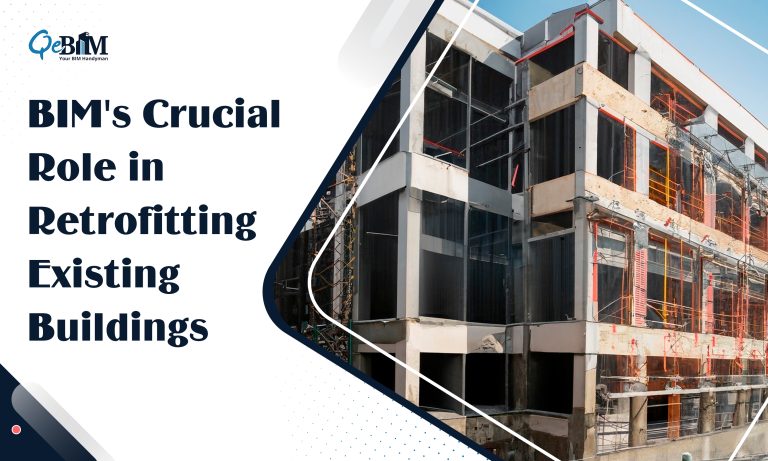BIM’s Crucial Role in Retrofitting Existing Buildings

Introduction:
In the relentless pursuit of a sustainable future, the architectural and construction industry stands at a critical juncture. With the increasing awareness of the environmental repercussions associated with buildings, the focus on retrofitting existing structures for energy efficiency and sustainability has gained momentum. Building Information Modelling (BIM), a powerful digital tool that facilitates collaborative and efficient design and construction processes, emerges as a key player in the quest for greener buildings. In this blog post, we will see how BIM Services can enable successful green retrofits, backed by compelling statistics.
Understanding Green Retrofits:
Green retrofits involve the integration of environmentally friendly practices and technologies into existing buildings, aiming to enhance energy efficiency, reduce carbon footprints, and improve overall sustainability. The process is inherently challenging, as existing structures often present limitations and complexities that new constructions may not.
Enter BIM:
BIM, with its comprehensive and data-driven approach, is proving to be a game-changer in the field of green retrofits. Here’s how:
1) Precise Data for Informed Decision-Making:
BIM provides a centralized digital platform where architects, engineers, and contractors can collaborate and access detailed information about the existing building. This includes structural details, material specifications, and historical performance data. Equipped with this accurate information, stakeholders can make well-informed decisions regarding the most efficient and sustainable retrofit strategies.
Statistic: A study by McGraw Hill Construction found that projects utilizing BIM reported a 45% reduction in errors and omissions, leading to more informed decision-making.
2) Energy Analysis and Simulation:
BIM allows for sophisticated energy analysis and simulation, enabling professionals to assess the current energy performance of a building and model the impact of various retrofit options. This functionality is crucial in identifying the most effective energy-saving measures and optimizing the return on investment.
Statistic: According to a report by Dodge Data & Analytics, projects using BIM for energy analysis reported a 25% reduction in energy consumption on average.
3) Streamlined Collaboration:
Green retrofits involve multiple stakeholders, from architects to contractors and building owners. BIM facilitates seamless collaboration by providing a shared digital environment where all parties can contribute and access information in real-time. This integrated approach minimizes communication gaps and ensures that everyone is on the same page throughout the retrofitting process.
Statistic: The National BIM Report 2022 highlighted that 76% of surveyed construction professionals believe that BIM improves collaboration and coordination among project teams.
4) Cost Estimation and Life-Cycle Analysis:
BIM goes beyond the construction phase by enabling accurate cost estimation and life-cycle analysis. This is particularly valuable in green retrofits, where long-term sustainability and cost-effectiveness are paramount. By considering the life-cycle costs of different retrofit options, stakeholders can make decisions that balance upfront expenses with ongoing operational savings.
Statistic: According to the NIST Cost Analysis of Inadequate Interoperability in the U.S. Capital Facilities Industry, the U.S. capital facilities sector incurs an estimated annual cost of $15.8 billion due to insufficient interoperability, a challenge addressed by BIM.
5) Regulatory Compliance and Documentation:
Green retrofits often involve compliance with evolving environmental regulations. BIM allows for the integration of regulatory requirements into the design and documentation process, ensuring that retrofits meet current standards and are well-documented for future reference.
Statistic: A survey by Autodesk and Dodge Data & Analytics found that 79% of construction professionals believe that BIM helps them comply with regulations and codes more effectively.
BIM: A Step Towards Sustainable Future Ahead
In the pursuit of sustainable and energy-efficient buildings, the role of BIM in enabling successful green retrofits cannot be overstated. As the statistics suggest, BIM contributes to informed decision-making, streamlined collaboration, energy efficiency, and long-term cost-effectiveness. As the industry continues to evolve, embracing BIM in the retrofitting process is not just a choice but a necessity to create a greener, more sustainable built environment.
By leveraging the power of BIM Outsourcing Services, we can transform existing buildings into beacons of sustainability, reducing environmental impact and paving the way for a brighter, more eco-friendly future. The statistics speak for themselves, highlighting the tangible benefits that BIM brings to the table in the quest for green retrofits and a more sustainable built environment.